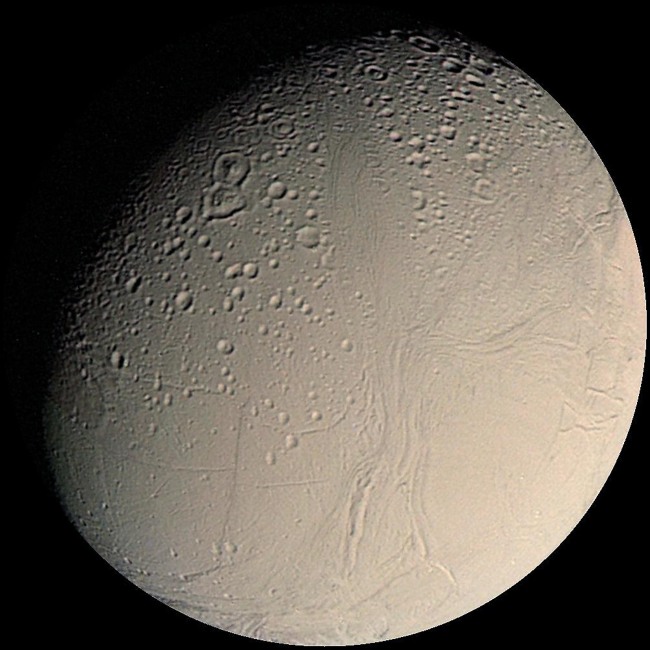
PARIS (AFP) ― Enceladus, a white moon of Saturn with ice-spewing volcanoes, owes its strangeness to tides of gravitational forces exerted by its mother, a study said.
Discovered in 1789 by William Herschel, Enceladus measures only 504 kilometers across yet is one of the great oddities of the solar system.
Its surface is a gorgeous white shell of ice, rather than asteroid-pocked rock and dust, and the surface is pristine except for a network of fractures near its south pole.
These cracks ― dubbed “tiger stripes” ― emit fountains of water vapor that instantly turn into icy grains on contact with the chill vacuum of space. Some astrophysicists conclude that the worldlet harbors an ocean of saltwater, which in turn makes it a good candidate as a source for life.
But how can a sub-surface sea exist, if the ambient temperature is close to absolute zero ― and the sun is a distant dot?
The answer, say theorists, lies with a phenomenon called tidal forces. They argue that the gravitational pull exerted by Saturn, the second largest planet of the solar system, squeezes Enceladus’ innards, causing friction whose heat allows the water to remain in a liquid state. Long debated, the notion has now gained the support of comparisons of the icy plume as the moon crawls around Saturn on an egg-shaped orbit.
When Enceladus is closest to Saturn, the plume is at its dimmest, a sign that the fractures are being closed up by a mighty gravitational pull from the giant mother plant, and so relatively little water escapes, according to the new study.
When Enceladus is at its farthest point from Saturn, the plume is several times brighter, suggesting that the fractures open out ― rather like an unclenched fist ― and more water is disgorged. The evidence comes from 252 infra-red images taken by the great explorer probe Cassini during its lonely swings around the planet.
They provide “strong evidence that tidal forces do play an important role in controlling Enceladus’ plume activity, perhaps by changing the width of the conduits between the surface and various underground reservoirs,” says the paper, led by Matthew Hedman of Cornell University in New York.
Many of the icy grains from Enceladus fall back on its surface, which explains its dazzling white surface.
Discovered in 1789 by William Herschel, Enceladus measures only 504 kilometers across yet is one of the great oddities of the solar system.
Its surface is a gorgeous white shell of ice, rather than asteroid-pocked rock and dust, and the surface is pristine except for a network of fractures near its south pole.
These cracks ― dubbed “tiger stripes” ― emit fountains of water vapor that instantly turn into icy grains on contact with the chill vacuum of space. Some astrophysicists conclude that the worldlet harbors an ocean of saltwater, which in turn makes it a good candidate as a source for life.
But how can a sub-surface sea exist, if the ambient temperature is close to absolute zero ― and the sun is a distant dot?
The answer, say theorists, lies with a phenomenon called tidal forces. They argue that the gravitational pull exerted by Saturn, the second largest planet of the solar system, squeezes Enceladus’ innards, causing friction whose heat allows the water to remain in a liquid state. Long debated, the notion has now gained the support of comparisons of the icy plume as the moon crawls around Saturn on an egg-shaped orbit.
When Enceladus is closest to Saturn, the plume is at its dimmest, a sign that the fractures are being closed up by a mighty gravitational pull from the giant mother plant, and so relatively little water escapes, according to the new study.
When Enceladus is at its farthest point from Saturn, the plume is several times brighter, suggesting that the fractures open out ― rather like an unclenched fist ― and more water is disgorged. The evidence comes from 252 infra-red images taken by the great explorer probe Cassini during its lonely swings around the planet.
They provide “strong evidence that tidal forces do play an important role in controlling Enceladus’ plume activity, perhaps by changing the width of the conduits between the surface and various underground reservoirs,” says the paper, led by Matthew Hedman of Cornell University in New York.
Many of the icy grains from Enceladus fall back on its surface, which explains its dazzling white surface.
-
Articles by Korea Herald







![[Graphic News] More Koreans say they plan long-distance trips this year](http://res.heraldm.com/phpwas/restmb_idxmake.php?idx=644&simg=/content/image/2024/04/17/20240417050828_0.gif&u=)
![[KH Explains] Hyundai's full hybrid edge to pay off amid slow transition to pure EVs](http://res.heraldm.com/phpwas/restmb_idxmake.php?idx=644&simg=/content/image/2024/04/18/20240418050645_0.jpg&u=20240419100350)






![[From the Scene] Monks, Buddhists hail return of remains of Buddhas](http://res.heraldm.com/phpwas/restmb_idxmake.php?idx=652&simg=/content/image/2024/04/19/20240419050617_0.jpg&u=20240419175937)

![[KH Explains] Hyundai's full hybrid edge to pay off amid slow transition to pure EVs](http://res.heraldm.com/phpwas/restmb_idxmake.php?idx=652&simg=/content/image/2024/04/18/20240418050645_0.jpg&u=20240419100350)

![[Today’s K-pop] Illit drops debut single remix](http://res.heraldm.com/phpwas/restmb_idxmake.php?idx=642&simg=/content/image/2024/04/19/20240419050612_0.jpg&u=)